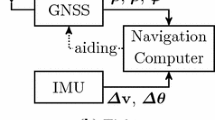Abstract
In 2006, we presented at DGON symposium in Stuttgart [2] the design and navigation results of MARINS, the first FOG-based navigation system within the class of 1 nautical mile per day. This navigation system in now in production and has been delivered to numerous navies.
Today we are challenged by even better performance and the question is: have we reached the limits of the technology or can we still improve the performance of our sensors? One nautical mile in a month means a bias stability of 2 × 10−5 degrees per hour! It may look foolish for a strapdown system with a dynamic range of at least 100 degrees per second. However, based on tests results, we provide evidence showing that FOG is the right technology to build a fully strapdown INS of this class. In particular we present:
-
•
Noise improvement.
-
•
Very long term pure inertial navigation (several weeks) of a FOG-based system with temperature controlled environment.
Of course, the present FOG design is not good enough for the required performance, even in a strictly controlled environment. The first way to go about this is obviously to increase the geometry factor (and therefore sensitivity) by increasing both diameter and length of the fiber coils, but this will not be sufficient. It will be necessary to improve detection noise, to control more accurately the light source wavelength, to reduce temperature gradient...Clearly there are difficulties on the way to a FOG-based strapdown system able to navigate with an accuracy of 1 nautical mile over several weeks; however, we show that FOG technology has not reached its ultimate potential yet and that the dream of even higher performance is within reach.
Similar content being viewed by others
References
Post, E.J., Sagnac effect, Review of Modern Physics, 1967, vol. 39, pp. 475–494.
Arditty, H.J., Graindorge, P., Lefèvre, H.C., Martin, P., Morisse, J., and Simonpiétri, P., Fiber-Optic Gyroscope with All-Digital Processing, OFS 6, Springer-Verlag Proceedings in Physics, 1989, pp. 131–136.
30th FOG Anniversary Session, OFS 18 Conference, Cancun, 2006
Aronowitz, F., Fundamentals of the Ring Laser Gyro, Optical Gyros and their Application, RTO AGARDograph 339, 1999, pp. 3-1–3-45.
Rozelle, D.M., The Hemispherical Resonator Gyro: from Wineglass to the Planets, Proceedings of the 19th AAS/AIAA Space Flight Mechanics Meeting, 2009, pp. 1157–1178.
Lefèvre, H., The Fiber-Optic Gyroscope, Boston-London: Artech House, 1992.
Savage, P.G., Strapdown Analytics, Maple Plain: Strapdown Associates, 2007.
Paturel, Y., et al., MARINS, the First FOG Navigation System for Submarines, Proceedings of Symposium Gyro Technology, 2006.
Author information
Authors and Affiliations
Additional information
Published in Giroskopiya i Navigatsiya, 2013, No. 3, pp. 3–13.
The article is published in the original.
Rights and permissions
About this article
Cite this article
Paturel, Y., Honthaas, J., Lefèvre, H. et al. One nautical mile per month fog-based strapdown inertial navigation system: A dream already within reach?. Gyroscopy Navig. 5, 1–8 (2014). https://doi.org/10.1134/S207510871401009X
Received:
Published:
Issue Date:
DOI: https://doi.org/10.1134/S207510871401009X




